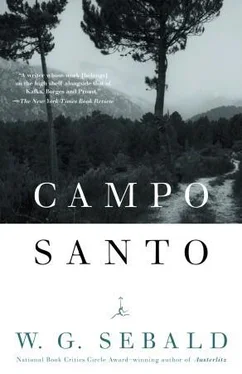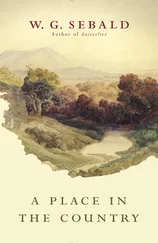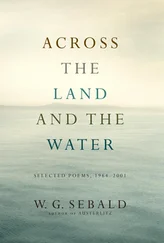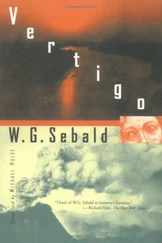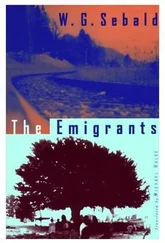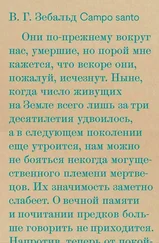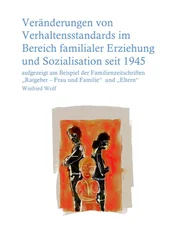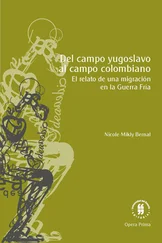Once upon a time Corsica was entirely covered by forest. Story by story it grew for thousands of years in rivalry with itself, up to heights of fifty meters and more, and who knows, perhaps larger and larger species would have evolved, trees reaching to the sky, if the first settlers had not appeared and if, with the typical fear felt by their own kind for its place of origin, they had not steadily forced the forest back again.
The degradation of the most highly developed plant species is a process known to have begun near what we call the cradle of civilization. Most of the high forests that once grew all the way to the Dalmatian, Iberian, and North African coasts had already been cut down by the beginning of the present era. Only in the interior of Corsica did a few forests of trees towering far taller than those of today remain, and they were still being described with awe by nineteenth-century travelers, although now they have almost entirely disappeared. Of the silver firs that were among the dominant tree species of Corsica in the Middle Ages, standing everywhere in the mists clinging to the mountains, on overshadowed slopes and in ravines, only a few relics are now left in the Marmano valley and the Forêt de Puntiello; and on a walk there, a remembered image came into my mind of a forest in the Innerfern through which I had once gone as a child with my grandfather.
A history of the forests of France by Etienne de la Tour, published during the Second Empire, speaks of individual firs growing to a height of almost sixty meters during their lives of over a thousand years, and they, so de la Tour writes, are the last trees to convey some idea of the former grandeur of the European forests. He laments the destruction of the Corsican forests par des exploitations mal conduites (by mismanaged exploitation), which was already becoming a clear menace in his time. The stands of trees spared longest were those in the most inaccessible regions, for instance the great forest of Bavella, which covered the Corsican Dolomites between Sartène and Solenzara and was largely untouched until toward the end of the nineteenth century.
The English landscape painter and writer Edward Lear, who traveled in Corsica in the summer of 1876, wrote of the immense forests that then rose high from the blue twilight of the Solenzara valley and clambered up the steepest slopes, all the way to the vertical cliffs and precipices with their overhangs, cornices, and upper terraces where smaller groups of trees stood like plumes on a helmet. On the more level surfaces at the head of the pass, the soft ground on which you walked was densely overgrown with all kinds of different bushes and herbs. Arbutus grew here, a great many ferns, heathers and juniper bushes, grasses, asphodels, and dwarf cyclamen, and from all these low-growing plants rose the gray trunks of Laricio pines, their green parasols seeming to float free far, far above in the crystal-clear air.
“At three the top of the pass … is reached,” says Lear, “and here the real forest of Bavella commences, lying in a deep cup-like hollow between this and the opposite ridge, the north and south side of the valley being formed by the tremendous columns and peaks of granite … which stood up like two gigantic portions of a vast amphitheatre,” with the sea beyond them, and the Italian coast like a brush stroke drawn on paper. These crags, he writes, “are doubly awful and magnificent now that one is close to them, and excepting the heights of Serbal and Sinai, they exceed in grandeur anything of the kind I have ever seen.” But Lear also comments on the timber carts drawn by fourteen or sixteen mules which even then were making their way along the sharply winding road, transporting single trunks a hundred to a hundred and twenty feet long and up to six feet in diameter, an observation that I found confirmed in 1879 by the Dictionnaire de géographie edited by Vivien de Saint-Martin, in which the Dutch traveler and topographer Melchior van de Velde writes that he has never seen a finer forest than the forest of Bavella, not even in Switzerland, Lebanon, or on the islands of Indochina.
Bavella est ce que j’ai vu de plus beau en fait de forêts , says van de Velde, adding this warning: Seulement, si le touriste veut la voir dans sa gloire, qu’il se hâte! [4] Of the forests I have seen, Bavella is the loveliest.… Only, if the tourist wishes to see it in its glory, he must make haste!
La hache s’y promène et Bavella s’en va! The ax is abroad and Bavella is disappearing. And indeed, nothing in the Bavella area today is as it must then have been. It is true that when you first climb to the pass from the south, coming closer and closer to the rocky peaks, which are violet to purple in color and are often surrounded halfway up by wreaths of vapor, and then look down from the edge of the Bocca into the Solenzara valley, it seems at first as if the wonderful forests praised by van de Velde and Lear were still standing. In truth, however, no trees grow here except those planted by the forestry department on the site of the great fire of the summer of 1960: slender conifers which cannot be imagined lasting a single human lifetime, let alone for dozens of generations.
The ground under these meager pines is largely bare: I myself saw not the slightest trace of the wealth of game mentioned by earlier travelers— le gibier y abonde , writes van de Velde. Ibex were once extremely abundant here, eagles and vultures soared above the rock slides, hundreds of siskins and finches darted through the canopy of the forest, quail and partridge nested under the low shrubs, and butterflies fluttered everywhere around you. The creatures of Corsica are said to have been strikingly small, a phenomenon that sometimes occurs on islands.
Ferdinand Gregorovius, who traveled in Corsica in 1852, mentions an entomologist from Dresden whom he met in the hills above Sartène, and who told him that the island had struck him as a paradise garden on his first visit, particularly because of the small size of its fauna species, and indeed, writes Gregorovius, soon after he met the Saxon entomologist he had several sightings in the forest of Bavella of the Tyrrhenian red deer, Cervus elaphus corsicanus , now long since extinct, an animal of dwarfish stature and almost oriental appearance, with a head much too large for the rest of its body, and eyes wide with fear in constant expectation of death.
Although the game that once lived in such abundance in the forests of the island has been eradicated almost without trace today, the fever of the chase still breaks out on Corsica every September. During my excursions into the interior of the island I repeatedly felt as if the entire male population were participating in a ritual of destruction which long ago became pointless. The older men, usually wearing blue dungarees, are posted beside the road all the way up into the mountains; the young men, in a kind of paramilitary gear, drive around in jeeps and cross-country vehicles as if they thought the countryside were occupied, or they were expecting an enemy invasion. Unshaven, carrying heavy rifles, menacing in their manner, they look like those Croatian and Serbian militiamen who destroyed their native land in their deranged belligerence; and, like those Marlboro-style heroes of the Yugoslavian civil war, the Corsican hunters are not to be trifled with if you happen to stray into their territory.
More than once on such meetings they plainly indicated that they did not want to talk to some chance-come hiker about their sanguinary business, and sent me on my way with a gesture making it clear that anyone who did not get out of the danger zone very quickly might easily be shot down. Once, a little way below Evisa, I tried to strike up a conversation with one of the hunters posted beside the road and obviously taking his task very seriously, a short man of around sixty who was sitting, his double-barreled shotgun across his knees, on the low stone balustrade which fences off the road at that point from the ravine of the Gorges de Spelunca, where it drops to two hundred meters below. The cartridges he had with him were very large, and the belt carrying them was so broad that it reached like a leather jerkin from his belly to halfway up his chest. When I asked him what he was looking for, he simply replied sangliers (wild boars), as if that alone must suffice to send me packing. He would not have his photograph taken, but warded me off with his outspread hand just as guerrillas do in front of the camera.
Читать дальше
